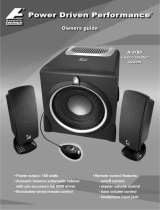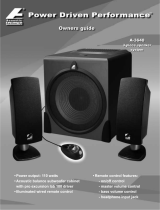
iFi SPEAKER SYSTEM
Die Fernbedienung verfügt über fünf Tasten, die wichtige Player-
Funktionen eines in der Dockingsta
tion befindlichen iPods regeln. Da
es sich um eine Funk-Fernbedienung (RF) statt einer Infrarot-
Fernbedienung handelt, muss sie nicht direkt auf die iFi-
Dockingstation ausgerichtet werden. Die Fernbedienung kann das iFi-
System aus bis zu 30 m Entfernung kontrollieren (je nach
Umgebungsbedingungen) und durchdringt sogar
Wände und Decken.
Solange der Netzschalter eingeschaltet und der Subwoofer auf „Ein“
gestellt ist, können Sie durch Drücken der Taste Play/Pause auf der
Fernbedienung das System von „Standby“ auf „Ein“ schalten.
Lautstärke lauter/leiser
Durch Drücken der Plustaste erhöhen Sie die Lautstärke, durch
Drücken der Minustaste senken Sie diese ab.
Play/Pause
Wenn der iPod nicht spielt, drücken Sie die Taste Play/Pause ein Mal,
um mit der Wiedergabe zu beginnen. Wenn der iPod spielt, drücken
Sie die Taste Play/Pause ein Mal, um den aktuellen Titel zu pausieren.
Wenn der iPod pausiert, drücken Sie die Taste Play/Pause ein Mal, um
die Wiedergabe des aktuellen Titels fortzusetzen.
Wenn Sie die Taste Play/Pause 3 Sekunden lang gedrückt halten,
schaltet dies das iFi-System und den angedockten iPod in den
Standby-Modus. Solange der Netzschalter des Subwoofers auf „Ein“
steht, wird der iPod weiterhin aufgeladen.
Tasten „Vorwärts springen“/„Rückwärts springen“
Wenn der iPod spielt, können Sie durch Drücken der Taste „Vorwärts
springen“ zum nächsten Titel der Wiedergabeliste springen. Wenn Sie
die Taste „Rückwärts springen“ drücken, springen Sie zum Beginn des
jetzigen Titels. Wenn Sie zu Beginn eines Titels die Taste „Rückwärts
springen“ drücken, springen Sie zum vorherigen Titel in der
Wiedergabeliste zurück. Wenn Sie die Tasten „Vorwärts springen“ oder
„Rückwärts springen“ einige Sekunden gedrückt lassen, wird der jet-
zige Titel vor- oder zurückgespult.
Synchronisieren der Fernbedienung mit der Dockingstation
Nach Auslieferung muss die Dockingstation nicht mit der
Fernbedienung synchronisiert werden, so dass jede iFi-Fernbedienug
das System steuern kann. Wenn es zu Problemen kommt, da mehrere
Systeme in nächster Nähe betrieben werden, kann die Fernbedienung
an die Dockingstation angepasst werden, indem Sie bei eingeschal-
tetem System die Taste Play/Pause 10 Sekunden gedrückt lassen. Die
Einheit geht dann in den Standby-Modus über und ist nach 10
Sekunden korrekt synchronisiert. Von nun an funktioniert das System
nur mit den synchronisierten Fernbedienungen.
WICHTIG: Wenn es keine Probleme gibt, muss die Fernbedienung
nicht synchronisiert werden. Wenn ein Problem auftritt, sollte während
der Synchronisierung des einen Systems das andere vom Netz
getrennt sein, damit die Fernbedienungen nicht mit beiden Systemen
synchronisiert werden. Nach Abschluss des Verfahrens kann es für das
zweite System durchgeführt werden, wobei das erste System vom
Netz zu trennen ist. Wenn Sie weitere Fragen über Ihr neues iFi-
System ha
ben, rufen Sie den Klipsch-Kundendienst unter (USA)
1-800-KLIPSCH an.
Ersetzen der Fer
nbedienungsbatterie
Um die Batterie auszutauschen, entfernen Sie die zwei Schrauben auf
der Rückseite der Fernbedienung und nehmen die Abdeckung wie
gezeigt ab.
PFLEGE UND REINIGUNG
Die einzig nötige Pflege Ihrer Lautsprecher besteht darin, sie
gelegentlich abzustauben. Verwenden Sie nie Scheuermittel,
Lösungsmittel enthaltende oder aggressive Reinigungsmittel. Sie
können die Lautsprechergrills mit dem Bürstenaufsatz eines
Staubsaugers reinigen.
STÖRUNGSBESEITIGUNG
Der iPod lässt sich nicht richtig an das System andocken
•Vergewissern Sie sich, dass der richtige iPod-Adapter in der
Dockingstation eingesetzt ist.
•Entfernen Sie den iPod; prüfen Sie die Anschlüsse an der
Dockingstation und der Unterseite des iPods, um sicherzustellen, dass
keine Behinderungen vorliegen.
Kein Sound
•Vergewissern Sie sich, dass das Netzkabel an der Rückseite des
Subwoofers und in der Steckdose eingesteckt ist, dass der
Netzschalter auf „Ein“ steht und dass das iFi-System eingeschaltet ist.
Die Netz-LED an der Dockingstation sollte grün leuchten.
•Vergewissern Sie sich, dass der iPod richtig in der Dockingstation
sitzt, eingeschaltet ist und spielt.
•Wenn ein externes Gerät an den AUX-Eingang der Dockingstation
angeschlossen ist, müssen Sie sicherstellen, dass es eingeschaltet ist
und spielt. Wenn Sie den iPod in der Dockingstation hören wollen,
müssen Sie das AUX-Kabel von der Dockingstation entfernen.
•Vergewissern Sie sich, dass die Lautstärke nicht heruntergedreht ist,
was Sie am Leuchtbalken an der Dockingstation ablesen können.
iPod lädt sich nicht auf
•V
ergewissern Sie sich,
dass der iPod korrekt in die Dockingsta
tion
eingeführt ist.
•V
ergewissern Sie sich,
dass das Netzkabel des Systems eingesteckt
ist und dass der Netzschalter auf der Rückseite des Subwoofers auf
„Ein“ steht.
W
enn der Netzschalter auf „Aus“ steht, lädt sich der iPod
nicht auf.
Fer
nbedienung kann das System nic
ht steuer
n
•V
ergewissern Sie sich,
dass die Ba
tterie richtig installiert wurde.
•W
enn die Ba
tterie alt ist,
muss sie eventuell ersetzt werden.
Es besteht ein Konflikt zwisc
hen der Fer
nbedienung und einem
ander
en iFi-System in der Nähe
• Um Konf
likte zu vermeiden,
muss die Fernbedienung korrekt mit























